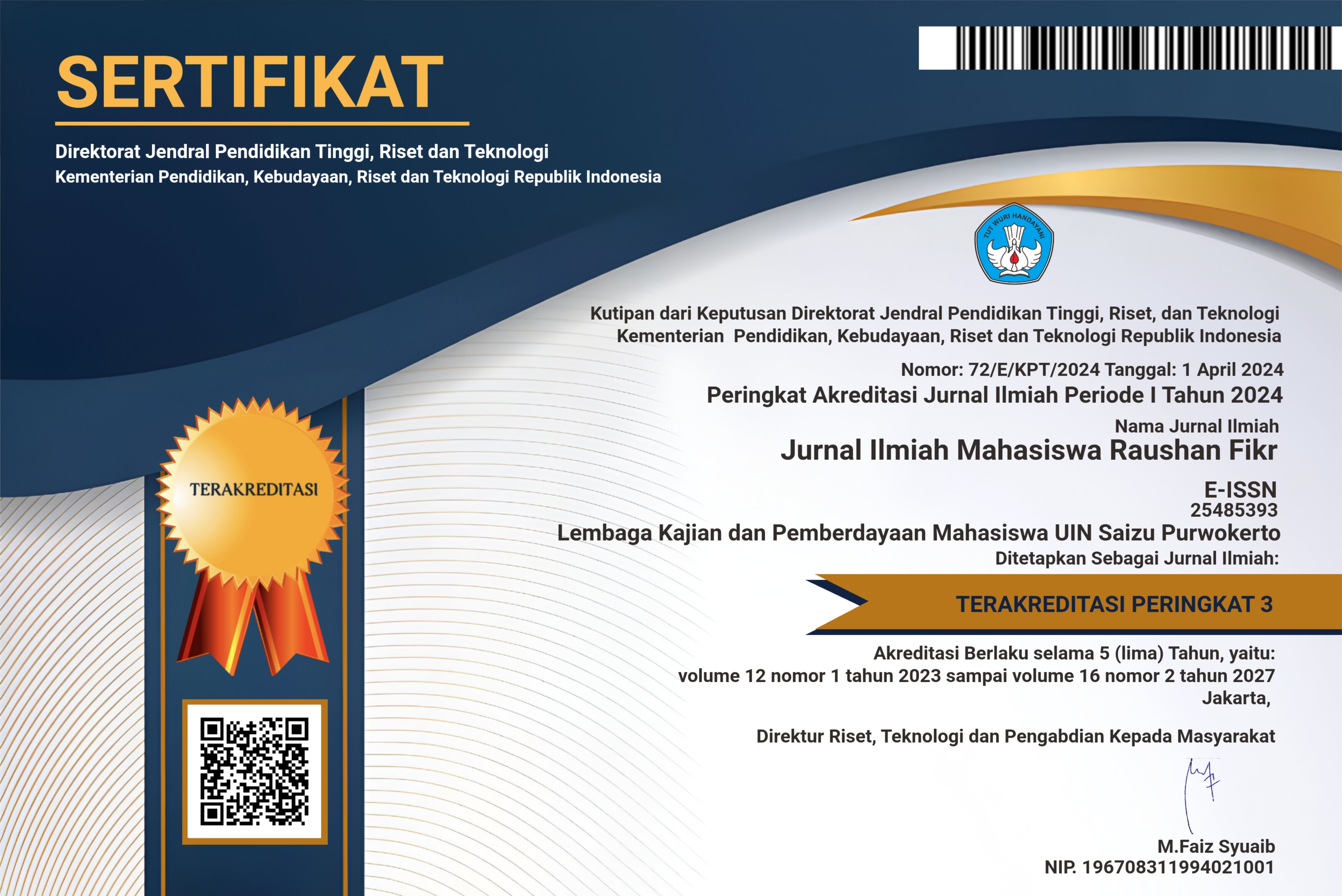Maqāṣid Asy-Syarī’ah Apart from Uṣūl Fiqh? An Offer on Islamic Law System Spinoff
DOI:
https://doi.org/10.24090/jimrf.v12i1.6633Keywords:
Fiqh, Purpose, Philosophy, SpinoffAbstract
The use of uṣūl fiqh and maqāṣid asy-syarī’ah as methods of finding and verifying law often causes them to overlap and even self-contradict. Therefore, it is necessary to understand the principle of motion, then operate them in their respective parts. This paper aims to examine the principles of motion of each and build a reciprocal relationship between them. This research is qualitative-documentative, with data collected from books and journals. This study concludes that initially, maqāṣid asy-syarī’ah adheres to the principle of motion of istinbāṭī uṣūl al-fiqh, then becomes a spinoff with the principles of philosophical, analytic, and applicable motion to apply the law. The position of maqāṣid asy-syarī’ah as a spinoff has the consequence that it becomes an independent part of the Islamic legal systemDownloads
References
Āfandī, S. H. (1932). Al-Ḥuṣūn al-Ḥamīdiyyah. Maktabah al-Jāriyyah al-Kubrā.
al-Ajfān, M. A. (1984). Fātawā al-Imām asy-Syāṭibi̇ (2nd ed.). al-Kawākib.
al-Āmidī, ‘Alī bin Muhammad. (2003). Al-Iḥkām fī Uṣūl al-Aḥkām (1st ed., Vol. 4). Dār aṣ-Ṣamī’ī.
al-Būṭī, S. R. (n.d.). Ḍawābiṭ al-Maṣlaḥah fi asy-Syarī’ah al-Islāmiyyah. Mu’assasat ar-Risālah.
al-Ījī, ‘Aḍd ad-Dīn ‘Abd ar=Raḥman. (2004). Syarah Mukhtaṣar al-Muntahā al-Uṣūlī (1st ed., Vol. 3). Dār al-Kutub al-Ilmiyyah.
al-Juwainī, al-I. al-Ḥaramain A. al-M. ‘Abd al-M. bin ‘Abd A. nbin Y. (1399). Al-Burhān fī Uṣūl al-Fiqh (1st ed.). Jāmi’ah Qaṭr.
an-Najār, ‘Abd al-Majīd. (2008). Maqāṣid as-Syarī’ah bi Ab’ād Jadīdah (2nd ed.). Dār al-Gharb al-Islāmī.
ar-Raisūnī, A. bin ‘Abd as-Salām. (2010). Madkhal ilā Maqāṣid asy-Syarī’ah (1st ed.). Dār al-Kalimah.
ar-Raisūnī, A. bin ‘Abd as-Salām. (2014). At-Tajdīd al-Uṣūlī (1st ed.). The International Institute of Islamic Thought.
ar-Rāzī, al-I. al-U. an-N. al-M. F. ad-D. M. bin ‘Umar bin al-Ḥusain ar-Rāzī. (1992). Al-Maḥṣūl fī ‘Ilm Uṣūl al-Fiqh (2nd ed., Vol. 1). Mu’assasat ar-Risālah.
as-Sulamī, al-I. al-M. S. al-’Ulamā’ A. M. ‘Izz ad-D. ‘Abd al-’Azīz bin ‘Abd as-Salām. (2014). Qaw̄’id al-Aḥkām fī Maṣāliḥ al-Anām (3rd ed., Vol. 1). Dār al-Kutub al-’Ilmiyyah.
Asasriwarnia, A., & Jandra, M. (2018). Comparison Of Legal System: Islamic Law System, Civil Law, and Common Law. UMRAN - International Journal of Islamic and Civilizational Studies, 5. https://doi.org/10.11113/umran2018.5n2-1.304
asy-Syāṭibī, al-’Alāmah al-M. A. I. I. bin M. M. al-Lakhmī. (1997a). Al-Muwāfaqāt (1st ed., Vol. 5). Dār Ibn ‘Affān.
asy-Syāṭibī, al-’Alāmah al-M. A. I. I. bin M. M. al-Lakhmī. (1997b). Al-Muwāfaqāt (1st ed., Vol. 2). Dār Ibn ‘Affān.
asy-Syuwaylī, ‘Alī Ghānim. (2018). Uṣül al-Fiqh wa Qawā’id al-Istinbāṭ baina an-Naẓariyah wa aṭ-Ṭaṭbīq (1st ed.). Dār al-Kalimāt li aṭ-Ṭibā’ah.
‘Āsyūr, al-I. Asy-S. M. aṭ-Ṭāhir I. (1984). Tafsīr at-Taḥrīr wa at-Tanwīr (Vol. 1). ad-Dār at-Tūnisiyyah.
‘Āsyūr, al-I. Asy-S. M. aṭ-Ṭāhir I. (2010). Maqāṣid asy-Syarī’ah al-Islāmiyyah. al-Maktabah al-Iskandariyyah.
Auda, J. (2012). Maqāṣid asy-Syarī’ah ka al-Falsafah li at-Tasyrī’ al-Islāmī (1st ed.). al-Ma’had al-alami li al-Fikr al-Islami.
az-Zuḥailị, W. (1986). Uṣūl al-Fiqh al-Islāmī (1st ed., Vol. 2). Daṝ al-Fikr.
Baderin, M. A. (2021). The Nature of Islamic Law. In M. A. Baderin (Ed.), Islamic Law: A Very Short Introduction (p. 0). Oxford University Press. https://doi.org/10.1093/actrade/9780199665594.003.0002
Bayah, A. Bin. (2006). ‘Alaqah Maqāṣid asy-Syarī’ah bi Uṣūl al-Fiqh. Mu’assasah al-Furqān li al-Turāṡ al-Islāmī.
Damanhuri. (2016). Ijtihad Hermeneutis (K. Anwar, Ed.; 1st ed.). IRCiSoD.
Daniels, T. P. (Ed.). (2017). Sharia Dynamics: Islamic Law and Sociopolitical Processes. Springer International Publishing.
Fārūq, B. (2013). Falsafah al-Fiqh. Dār al-Abḥāṡ.
Giorgio Levi Della Vida Conference. (1971). Theology and law in Islam / edited by G. E. von Grunebaum. OHarrassowitz.
Given, L. M. (Ed.). (2008). The SAGE Encyclopedia of Qualitative Research Methods (1 edition). SAGE Publications, Inc.
Gunstone, R. F. (Ed.). (2015). Encyclopedia of Science Education (1st ed.). Springer Reference.
Halim, F. (2010). Hubungan Antara Maqāṣid Al-Syarī’ah Dengan Beberapa Metode Penetapan Hukum (qiyās Dan Sadd/Fath Al-Żarī’ah). HUNAFA: Jurnal Studia Islamika, 7(2), Article 2. https://doi.org/10.24239/jsi.v7i2.94.121-134
Helim, A. (2019). Maqasid al-shari’ah versus usul al-fiqh: Konsep dan posisinya dalam metodologi hukum Islam (1st ed.). Pustaka Pelajar.
Masud, M. K. (1973). Shāṭibī’s Philosophy of Islamic Law [Dissertation].
Mutakin, A. (2017). Teori Maqâshid Al Syarî’ah dan Hubungannya dengan Metode Istinbath Hukum. Kanun Jurnal Ilmu Hukum, 19(3), Article 3.
Nassery, I., Ahmed, R., & Tatari, M. (Eds.). (2018). The Objectives of Islamic Law: The Promises and Challenges of the Maqāṣid al-Shariʻa. Lexington Books.
Opwis, F. M. M. (2010). Maṣlaḥa and the Purpose of The Law: Islamic Discourse on Legal Change from The 4th/10th to 8th/14th Century. Brill.
Qaraḍāwī, Y. al-. (2007). Dirāsah fī Fiqh Maqāṣid asy-Syarīʻah (3rd ed.). Dār asy-Syurūq.
Raz, J. (1971). The Identity of Legal Systems. California Law Review, 59(3), 795–815. https://doi.org/10.2307/3479604
Rigid body dynamics. (2020). In Wikipedia. https://en.wikipedia.org/w/index.php?title=Rigid_body_dynamics&oldid=967275457
Spinoff | Meaning in the Cambridge English Dictionary. (n.d.). Retrieved November 12, 2020, from https://dictionary.cambridge.org/dictionary/english/spin-off
‘Uṡmān, M. Ḥāmid. (2002). Al-Qāmūs al-Mubīn fi ̄Iṣṭilāḥāt al-Uṣūliyyịn (1st ed.). Dār az-Zaḥim.
Zahrah, M. A. (n.d.). Uṣūl al-Fiqh. Dār al-Fikr al-’Arabī.
Downloads
Published
How to Cite
Issue
Section
License
Copyright (c) 2023 Masykur Rozi, Subaidi Subaidi

This work is licensed under a Creative Commons Attribution-NonCommercial-ShareAlike 4.0 International License.
Authors who publish with this journal agree to the following terms:
- Authors retain copyright and grant the journal right of first publication with the work simultaneously licensed under a Creative Commons Attribution-NonCommercial-ShareAlike 4.0 International License that allows others to share the work with an acknowledgement of the work's authorship and initial publication in this journal.
- Authors are able to enter into separate, additional contractual arrangements for the non-exclusive distribution of the journal's published version of the work (e.g., post it to an institutional repository or publish it in a book), with an acknowledgement of its initial publication in this journal.
- Authors are permitted and encouraged to post their work online (e.g., in institutional repositories or on their website) prior to and during the submission process, as it can lead to productive exchanges, as well as earlier and greater citation of published work (See The Effect of Open Access).
















